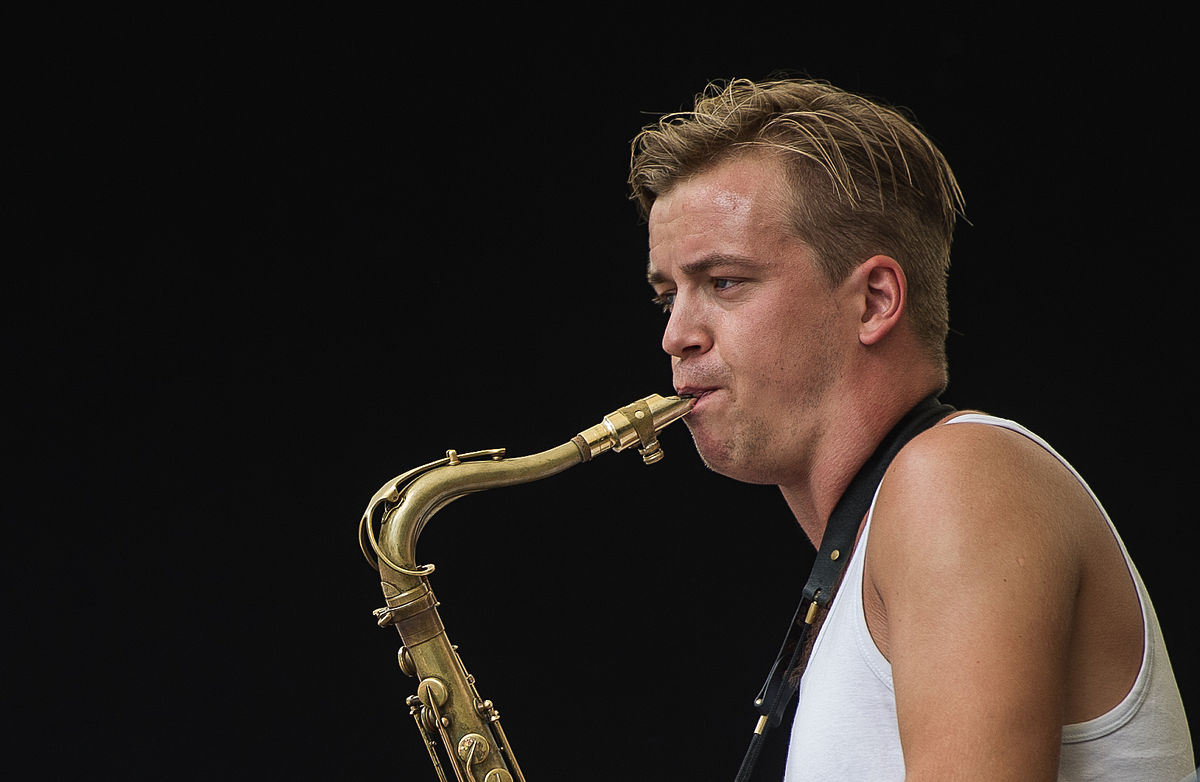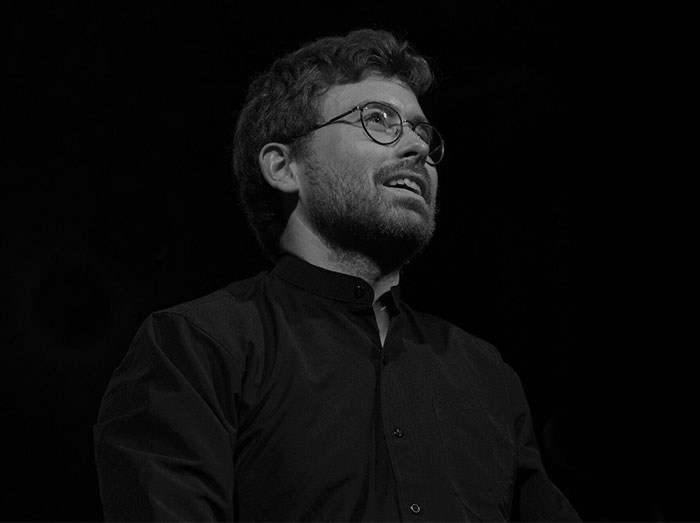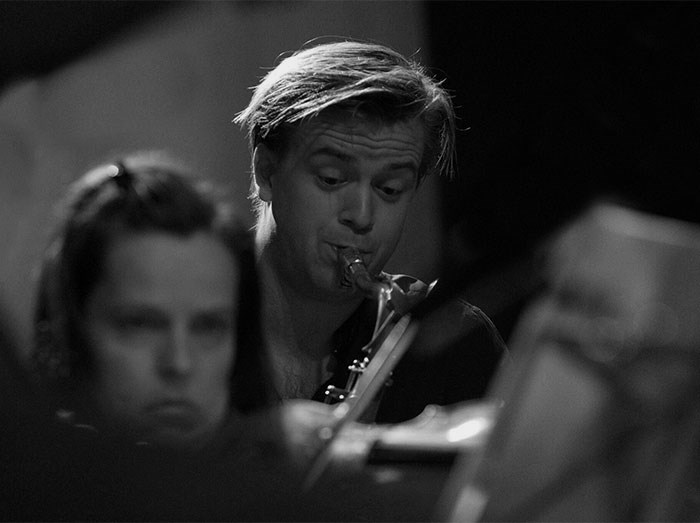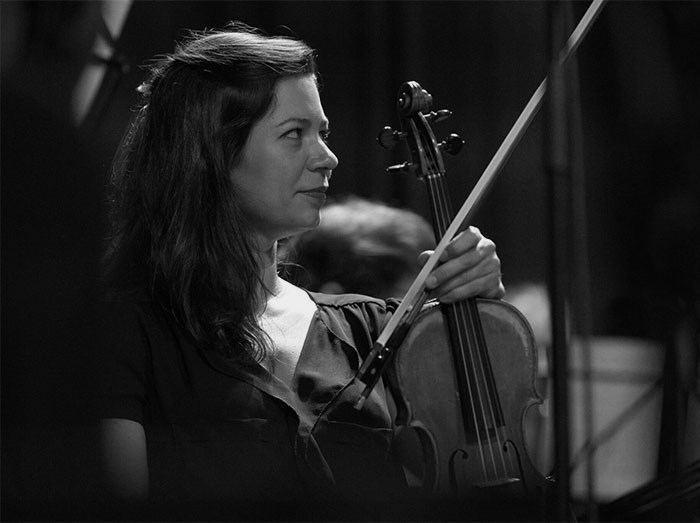Marius Neset Quartet, Geoffrey Paterson / Basel Sinfonietta
Jazz Compositions by Marius Neset (*1985)
Volkshaus, Basel, 2018-05-06

2018-05-11 — Original posting
Table of Contents
Introduction
I knew ahead of time that this would be a “borderline event” for me to review. Sure, I like and occasionally enjoy Jazz—but I have no education with this type of music, I don’t know the common Jazz standards, and I lack the vocabulary to describe what I’m hearing. I have always stated that I’m a lay critic—some musicians were kind enough to call my reviews “professional”, “in-depth”, “thorough”. I’m deeply honored by such comments, and I continually try my best to match the high expectations that this generates. However, to me, this concert is taking lay critiques to an entirely different level—so, please bear with me: I will essentially just describe my listening experience, without attempted analysis of the music.
In any case, it’s a long time since my wife and I heard the Sinfonietta in concert. We both felt that the Basel Sinfonietta deserves some extra attention, especially now that the orchestra is forced to resort to alternative concert venues, given that the traditional concert hall, the Stadtkasino Basel, is being renovated. And of course we had in mind the several interesting concerts with new and newest music that we had the pleasure to attend with this orchestra.
Venue, Context
This concert was given in the Volkshaus Basel, a community building in Kleinbasel. For details see my post on an earlier concert at this venue, also with the Basel Sinfonietta, on 2016-09-24. The location / venue is the only similarity between this and the earlier concert: in fact, this one wasn’t a concert “by the Basel Sinfonietta proper”, but rather one in which the Sinfonietta cooperated with the Offbeat Jazz Festival 2018 in Basel. Consequently, this wasn’t the usual orchestral concert, but rather a Jazz concert with the addition of the Basel Sinfonietta as “extended big band”, so to say (more on this below).
We had stall seats near the center of the hall, in row 12, around 2/3 into the hall, as seen from the stage.
All pieces played in this concert were compositions and arrangements by the Norwegian Jazz musician (composer, arranger, Saxophone artist) Marius Søfteland Neset (*1985, see also Wikipedia). Neset now lives in Copenhagen, where he also graduated from the Rhythmic Music Conservatory, in 2008. In the same institution, he finished his Soloist studies, in 2010. Since then, he has been pursuing a very successful career as Jazz composer and soloist.
The Artists
The Basel Sinfonietta played under the direction of Geoffrey Paterson (*1983, see also Wikipedia). The orchestra left a gap between the string section in the front, and the wind / percussion sections in the rear of the stage.
The gap between the two parts of the orchestra was occupied by Marius Neset and his Marius Neset Quartet, consisting of
- Marius Neset himself, playing soprano and tenor saxophone (in the center)
- Ivo Neame, piano (*1981, see also Wikipedia), on the left side of the stage
- Frans Petter Eldh, double bass (*1983, see also Wikipedia), to the right and slightly behind Marius Neset, and finally,
- Anton Eger, Jazz percussionist (*1980) on the right-hand side.
As usual in Jazz concerts, the quartet, but also the orchestra received “electronic assistance”, i.e., there were microphones everywhere, transmitting to two large sets of speakers on either side of the stage. In addition, the stage was “filled” with monitor loudspeakers, in order for the musicians to hear their own playing.
The Program
As mentioned, all pieces are by Marius Neset. The event ran under the title “Schmelzender Schnee” (“Melting Snow”)—a reference to the last piece of the evening, “Snowmelt”:
- Arches of Nature (2012 / 2015) — ca. 30′
- The Storm is Over (2012 / 2015) — ca. 10′
- Old Poison (XL) (2011) — tenor saxophone solo (Marius Neset), ca. 5′
(Intermission) - Birds (2012) — sax / piano / double bass / drums (Marius Neset Quartet), ca. 10′
- Math of Mars (2012) — ca. 9′
- Snowmelt (2012 / 2015) — ca. 13′
The durations are the estimates from the program booklet, not the actual timing. All of the pieces discussed below were performed in Switzerland for the first time.
Neset: Arches of Nature (2012 / 2015)
“Arches of Nature” includes seven segments, all performed in sequence and without interruption:
- Sirens
- Acrobatics
- Circles
- Caves
- Paradise
- Rainbows
- Pyramids
As the rest of the concert, this is clearly a Jazz piece, though certainly composed, not improvised, at its core (I’m sure that at least parts of the solos were improvised). According to the program notes, “Arches of Nature” is inspired by classical compositions. It relates to classical composition techniques, such as a dodecaphonic scale that appears in the middle of this work and moves from the saxophone to the bass, then to the piano, and finally to the bassoon. “Rainbows” quotes a theme from the Symphony No.10 by Gustav Mahler (1860 – 1911). And the last piece allegedly alludes to the “Circus Polka: For a Young Elephant” by Igor Stravinsky (1882 – 1971).
The Performance
Sirens
The piece starts with a solo for soprano saxophone. Neset “snook” into the music with a long crescendo on a single tone. He gradually broke off to other notes, then gradually (and improvising) moved into a melody, spanning widely, then Anton Eger joined in, with a momentary interjection at the drums, followed by the Jazz quartet. Gently, the orchestra joined in, with winds (flutes, bassoon) and strings. Neset switched to the tenor instrument, exhibiting amazing dynamic breadth. Trills in the flutes, soft staccato interjections on the bassoon evoked a lyrical dream world. Ascending, crescending scales. Birds singing?
I noted that in his introductory solo, Neset was fairly free in the intonation (I would usually refer to this as “expressive intonation”), and I wondered how this could possibly work together with the orchestra. Needless to say that Neset is flexible enough to adjust to the “local requirements”: as soon as he was playing with the orchestra, intonation was not even a consideration.
Acrobatics
Alternating, alarming dissonances in the flutes announced the next segment. The percussion gradually added rhythm and structure, drive, the volume and the complexity rapidly accumulated, built up to a complex (some might say cacophonic) climax of mostly wind voices and percussion. Another, dramatic build-up followed, broke off, for a double bass / percussion duo; the piano joins in, the quartet presents a lively, mostly improvised segment, with scarce orchestral accompaniment. The quartet then has a longer segment, in which Neset built up his part to great and greater complexity and virtuosity, breaking off at the climax.
Circles
A short intermezzo on percussion, double bass and piano leads into a calm, dreamy, lyrical orchestral segment, full of trills—I pictured the surface of a small lake, a pond in the morning, circles forming from bubbles that ascent to the surface; melancholic bird calls from the saxophone.
An acoustic feedback loop shortly disturbed the listening experience—this wasn’t the only instance, unfortunately…
Caves
Long, hollow tones initiated the “Caves” section. High notes join in, and a section of very high rhythmic complexity, along with a fabulous, virtuosic saxophone solo, and an extended, calmer, lyrical segment follows, seems to lose itself in the dark, underground world of a cave…
Paradise
A playful segment, piano, double bass plus percussion, presumably mostly improvised, gradually building up: a fabulous team of Jazz musicians, ending the segment with a double bass solo. The strings gently join in with the Jazz quartet. The latter appears to get carried away… and there was another series of interferences from acoustic feedback loops, where the strings had long, ascending lines. The feedback incidents were strong and long enough to make numerous people in the audience close their ears.
Rainbows
A slow, dreamy line in the strings (probably) indicates the appearance of a rainbow, accompanying an initially rather pensive, latter intensely singing solo on the tenor saxophone, gradually intensifying, moving into greater complexity.
Pyramids
A bassoon solo is followed by a percussion solo, the soprano saxophone joins in, building up a to a fascinating, virtuosic, polyrhythmic climax.
Conclusion
Excellent Jazz musicians, no doubt! What I regretted is that the role of the orchestra was essentially limited to that of big band accompaniment. Furthermore the Jazz quartet was heavily dominating the scene, to a degree where the role of the orchestra often went unnoticed. Somehow, the acoustic balance was non-ideal (but OK, this was essentially a Jazz event). Also, the feedback loops were disruptive incidents that did not seem to fit the quality standards of both the Jazz quartet and the orchestra.
Rating: ★★★
Neset: The Storm is Over (2012 / 2015)
It sure is not a mere coincidence that this shorter piece shows up after “Arches of Nature”: it takes up the theme of nature scenery.
The Performance
A calm, serene scene: resting chords with the string voices. Gradually. motifs, melody fragments joined in, form a murmuring background, above which the strings laid out beautiful cantilenas. Then, with the tenor saxophone, a ray of sunlight appeared to break through the clouds, blooming into beautiful melodies. In a calmer segment, one could picture birds singing, bees humming between flowers, more birds singing, light and shadow: almost too tonal, too harmonious too idyllic. There is a soft, broad climax, then the music retracts into a calmer ending, ultimately silence. In the last part, there were moments which reminded my of the Adagietto from the Symphony No.5 by Gustav Mahler (1860 – 1911). A very atmospheric piece, in which the orchestra could contribute adequately.
Rating: ★★★★
Neset: Old Poison (XL) (2011)
“Old Poison (XL)” is a composition for tenor saxophone solo that Marius Neset brought out in 2011, with the album “Golden Xplosion“.
The Performance
To me, this was the first true highlight of the evening, showing a true master on the tenor saxophone, with spectacular virtuosity: tone modulations, acrobatic, fast figures, pseudo-polyphony that seemed inspired by baroque music, playing with multiple resonances (duet playing on a single instrument), rhythmically enthralling: short, but utterly fascinating!
Rating: ★★★★★
Neset: Birds (2012)
This is a composition for Jazz quartet (soprano saxophone, piano, double bass, percussion), performed by the Neset Quartet. The program notes point to a combination of freely improvised, as well as composed passages. The text also reports influences by Igor Stravinsky (1882 – 1971), Charles Ives (1874 – 1954), Steve Reich (*1936), Wayne Shorter (*1933), Django Bates (*1960), Michael Brecker (1949 – 2007).
“Birds” actually is the first / title piece of an album with the same name, which appeared 2013.
The Performance
Without having looked up the above information from the program notes, the beginning immediately brought to mind Minimal Music. There were also moments that reminded me of the “Tintinnabuli Style” invented by Arvo Pärt (*1935). At the same time, tenor sax and percussion were truly enthralling! Harmonically, the structure is simple, at least during the extended saxophone solo. The piano then got a more important role—though, needless to say, that as long as Marius Neset was playing, he captured a lot of the listener’s attention. In typical Jazz manner, the music built up to a climax, then started anew.
In the next build-up, double bass and piano get a more prominent role, Neset merely accompanied with staccato sequences. Then, Anton Eger, the percussionist was let loose, and finally, the four musicians united for a long final, polyphonic, virtuosic build-up, which would have left the audience breathless, had there not been a calming, relaxed final coda.
Rating: ★★★★★
Neset: Math of Mars (2012)
“Math of Mars”, as performed here, is the orchestral version of No.9 from the same album “Birds”, see above.
The Performance
A really nice piece—so different from all others! The double bass introduces a pizzicato ostinato, based on a simple 8-tone motif, then the piano adds in a very simple, children’s song-like melody, again repeated: in its harmonic and melodic simplicity, the music reminded me of “Frère Jacques”. However, very soon, things seemed to “fall apart”, when Ivo Neame at the piano introduced a “totally asynchronous”, independent line in the left hand, then additional voices.
Frans Petter Eldh at double bass seemed to “fall out of rhythm”, suddenly introducing syncopes that disrupted his basic pattern, percussion and orchestra joined in: many simple elements forming a fascinating, complex texture above an almost simple, monotonous basis of two, three notes / chords. after a broad climax, the music calmed down gradually, until finally the strings, then everybody did a long, broad crescendo—and the piece abruptly ended on the dominant, without a final cadence.
Rating: ★★★★
Neset: Snowmelt (2012 / 2015)
Although not the longest of the compositions in this concert, “Snowmelt” has given the title to the entire concert. The original composition is for solo saxophone, chamber orchestra and five singers, which Marius Neset wrote upon commission by the Oslo Sinfonietta. 2015, Neset reworked the composition for his Jazz quartet and a bigger string orchestra. It was a performance of the Opera “Lulu” by Alban Berg (1885 – 1935) in Copenhagen, which inspired Marius Neset to write “Snowmelt”.
The Performance
The orchestra began the piece with syncopated, jazzy pizzicato rhythms, enriched by rattling from the percussion. Gradually, the Jazz quartet took over, above the constant pizzicato basis, and over a build-up, the music developed the drive and the perseverance of Ravel’s “Boléro”. Then, however, there is no holding back for the Jazz quartet, which now dominated completely, through a lengthy, truly enthralling and virtuosic, highly complex sequence, in which catchy melody fragments kept popping up: even just watching the Jazz musicians was fascinating!
When the quartet calmed down again (as if they had gotten exhausted), the pizzicato seemed to reappear—though it had probably been there most of the time. Gradually, the music mutated into a serene scenery (now definitely bringing to mind Mahler’s Adagietto). This was the background, above which a very melodic solo on the tenor saxophone gently ended the piece.
Rating: ★★★★
Encore, Conclusion
The encore was—expectedly—a Jazz piece just for the quartet: fast, full of drive and virtuosic tone repetitions, rhythmically enthralling. (★★★★★)
I can keep the summary short: Marius Neset, Ivo Neame, Petter Eldh, and Anton Eger are a team of top-class jazz musicians—no doubt about that. Marius Neset’s creative talent as composer and improviser, his artistry at the saxophone are truly excellent! It is hard to comment on Geoffrey Paterson’s work as conductor of the Basel Sinfonietta: their accompaniment was flawless—as much as it was prominent enough to be heard. For my personal taste, the acoustic balance was too heavily tilted towards the Jazz quartet. Finally, the incidents with the feedback loop during the first half of the concert should not have happened.









